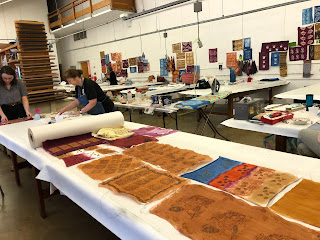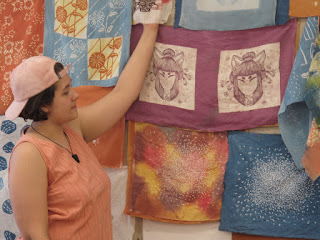FUCLUTY EXHIBITION Jan. 11 - Feb. 16, 2020
Evanston Art Center (Evanston, IL)
Opening reception on Jan. 19, 2020
Sunrise, Sunset #1
Hand cut-out and hand stitched. Hand dyed with natural dyes and indigo on silk, cotton, ramie, and handmade Japanese rice paper. Constructed.
12"H x 28"W x 5"D (two pieces together)
January 21, 2020
August 22, 2019
Further Evidence: The Art of Natural Dyes exhibition
May 28-July 14, 2019
Penland Gallery in North Carolina
Curated by Catharine Ellis (guest curator, artist, and educator)
total 16 artists were selected by Catharine Ellis and Kathryn Gremley (gallery director of Penland).
Recent piece, SUNRISE, SUNSET #2. Fabrics: Katazome (rice paste resist printing technique) with natural dyes on silk organza. Paper Panel: Dyed silk with natural dyes: madder, lac, weld, apple, cochineal, marigold, indigo. Applied traditional Japanese rice paper with scroll making technique. Hand cut out. Constructed. 86”H x 68”W x approx. 24”D
View from different angle.
Detail.
May 28-July 14, 2019
Penland Gallery in North Carolina
Curated by Catharine Ellis (guest curator, artist, and educator)
total 16 artists were selected by Catharine Ellis and Kathryn Gremley (gallery director of Penland).
Recent piece, SUNRISE, SUNSET #2. Fabrics: Katazome (rice paste resist printing technique) with natural dyes on silk organza. Paper Panel: Dyed silk with natural dyes: madder, lac, weld, apple, cochineal, marigold, indigo. Applied traditional Japanese rice paper with scroll making technique. Hand cut out. Constructed. 86”H x 68”W x approx. 24”D
View from different angle.
Detail.
January 18, 2019
Workshop for Marwen
I taught a workshop, "Sashiko and Boro stitching" for Marwen as a visiting artist.
Marwen is an art center for children in downtown Chicago, IL. There are various after school programs in painting, drawing, photography, sculpture, prints, metal, and fiber.
Although I normally do not teach children, I was interested in the program at Marwen, so I did it. It was fantastic! Great experience.
I introduced traditional SASHIKO (stitching) and BORO (stitching). Boro is a rug or waste cloth, and patched and mendid to repair originally in Japan. It can be an art form. Since we wanted to use all indigo blue shades, Rachel who invited me to teach a workshop, dyed fabric previously to make several shades of blue. Although I was not sure how much children can sew, many students (6th and 7th grade) tried to sew and they were fine! Children are very flexible and try to challenge a new art form. The workshop was a short time. Even so, Rachel will continue to instruct them to teach stitching following classes. Then after finishing the pieces, they will be displayed for the exhibition in the gallery at Marwen. Children will be excited to see their accomplishment.
Introduction of Sashiko stitching and Boro using my father's Kimono garment.
Example of my Indigo dyed and stitched piece.
Showing samples of Boro stitching.
Various samples of Boro stitching. There are many shades of blue.
Student is stitching. photo by Rachel Hill /Marwen
Student is stitching. photo by Rachel Hill /Marwen
Student is stitching. photo by Rachel Hill /Marwen
Marwen is an art center for children in downtown Chicago, IL. There are various after school programs in painting, drawing, photography, sculpture, prints, metal, and fiber.
Although I normally do not teach children, I was interested in the program at Marwen, so I did it. It was fantastic! Great experience.
I introduced traditional SASHIKO (stitching) and BORO (stitching). Boro is a rug or waste cloth, and patched and mendid to repair originally in Japan. It can be an art form. Since we wanted to use all indigo blue shades, Rachel who invited me to teach a workshop, dyed fabric previously to make several shades of blue. Although I was not sure how much children can sew, many students (6th and 7th grade) tried to sew and they were fine! Children are very flexible and try to challenge a new art form. The workshop was a short time. Even so, Rachel will continue to instruct them to teach stitching following classes. Then after finishing the pieces, they will be displayed for the exhibition in the gallery at Marwen. Children will be excited to see their accomplishment.
Introduction of Sashiko stitching and Boro using my father's Kimono garment.
Example of my Indigo dyed and stitched piece.
Showing samples of Boro stitching.
Various samples of Boro stitching. There are many shades of blue.
Student is stitching. photo by Rachel Hill /Marwen
Student is stitching. photo by Rachel Hill /Marwen
Student is stitching. photo by Rachel Hill /Marwen
I taught Katazome workshop in the summer, 2018 at Arrowmont School of Arts and Crafts. It was only for a week and it was very intense. Even so, we went through whole process; designing and cut out stencils, cooking rice paste, spreading rice paste through stencil, brushing soy milk, alum, and natural dyes, such as Lac, Weld, Madder, and Logwood finishing to set colors. We made a indigo dye vat and dipped rice pasted fabric. Also we dipped already colored with natural dye; yellow of Weld made lovely green after dipping it into indigo dye bath.
Amy is spreading the rice paste out through her exquisite stencil. See the below.
We started to cut small stencils. The black color stencil is attached SHA(silk gauze) for screen.
During the class. Arrowmont has a large space with wonderful equipment that we need.
It was a full class. Everyone was truly creative, patient, and hard working students. I loved them!!!
During the critique. They were productive! I was impressed by student who came from different back ground, not fiber. Even so, the core is an art. Use of different medium must be a great opportunity to discover new direction. Especially young people who pracite different meium tried to lean Katazome, and I admired their experimentation.
Amy is spreading the rice paste out through her exquisite stencil. See the below.
We started to cut small stencils. The black color stencil is attached SHA(silk gauze) for screen.
Brushing Lac on fabric. This way with bamboo stretchers is traditional Katazome, and it stretches both directions. It dries quickly, and it can be used long fabric, e.g. ten yard!
Community piece with Weld. Everyone contributed his/her own stencil with rice paste. Then we dipped it into indigo dye vat to make an emerald green color.
During the class. Arrowmont has a large space with wonderful equipment that we need.
It was a full class. Everyone was truly creative, patient, and hard working students. I loved them!!!
During the critique. They were productive! I was impressed by student who came from different back ground, not fiber. Even so, the core is an art. Use of different medium must be a great opportunity to discover new direction. Especially young people who pracite different meium tried to lean Katazome, and I admired their experimentation.
May 8, 2018
My piece, "Coexistence #20" is in the show, Hoop Dreams.The gallery space is upstairs at Lillstreet Art Center.
#LillstreetHoopDreams
June 1 - July 7 | Annex Gallery
Opening Reception: Friday, June 1
Save the date, and join us on opening night for an Instagram-curated exhibition in the Lillstreet Annex Gallery. Featuring 17 artists from across the country, this selection of artists has been brought together by a world wide web of threads.
August 27, 2017
Katazome with Natural Dyes & Indigo
Katazome with Natural Dyes & Indigo workshop (two weeks session)
at the Penland School of Crafts, summer 2017
I would like to share the photos of the students: They did wonderful work!!! They followed the basic rice paste resist technique, then pushed harder to develop the possible way to use the technique. It was impressive to observe their development.
Madolin Yoshikane
at the Penland School of Crafts, summer 2017
I would like to share the photos of the students: They did wonderful work!!! They followed the basic rice paste resist technique, then pushed harder to develop the possible way to use the technique. It was impressive to observe their development.
Amy Taylor
Lisa Yoneno
Madolin Yoshikane
River Takada-Capel
Ariel Lauren Wilson
Joan Raymond
Jan Quarles
Jessica Hammond
Margret Mills
Alyssa Dyar
Mirrah Johnson
Tyshawn Henry
November 8, 2016
Trace/Memory Exhibition at the Fort Lewis College: Akemi Cohn
More pictures from the Trace/Memory exhibition (October-November, 2016) at the Fort Lewis College, Colorado). Shown total 13 pieces.
Left: Remembrance #B Japanese rice paper dyed with indigo. Painted natural dyes. Sumi ink. Hand stitched. Hand cut-out. Constructed. 13"H x 68"W x 7"D total five pieces.
Right: Memory of Marigold #1 Silk dyed with natural dyes. Katazome (rice paste resist printing technique), applied Japanese scroll making technique. Hand cut-out. Constructed. 34"H x 48:W x 20"D
left: Cycle of Renewal #4 Japanese rice paper dyed with indigo and natural dyes. Applied traditional Japanese rice paper with scroll making technique. Hand cut-out. Constructed. 28"H x 50"W x 7"D
right: Cycle of Renewal #1 Japanese rice paper dyed with Indigo. Hand cut-out and constructed. 58"H x 120"W (4 panels, each panel 29"Wx58"W)
Left: Remembrance Fel and wool. Hand stitched. Indigo dyed. 39"H x 56"W
Right: Relocation #! Color rice paste resist printing (Nassen Katazome) on silk.
Hand stitched with indigo dyed thread. Applique. 53"H x 93"D
The center piece: Relocation #3 Hand cut-out fabric, paint, Nassen Katazome on silk organza. Constructed. 86"H x 68"W x approx. 24"D
Subscribe to:
Comments (Atom)









































